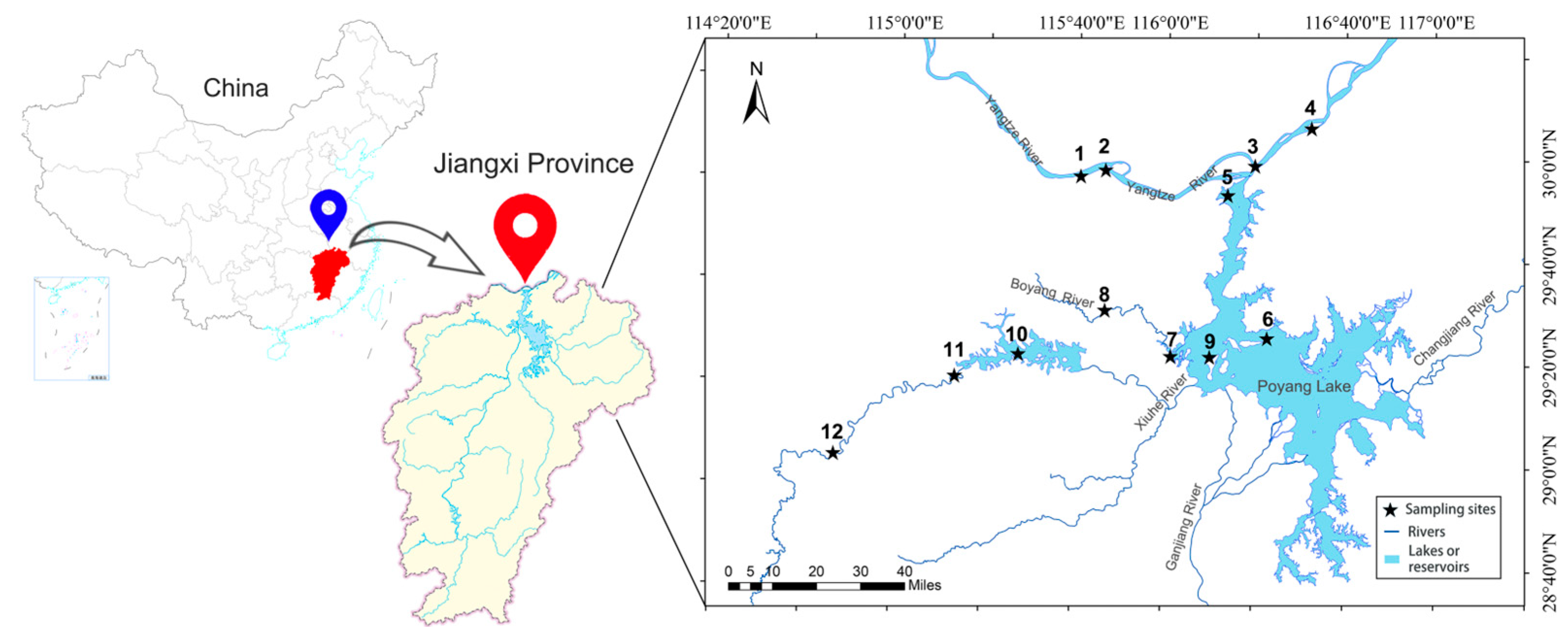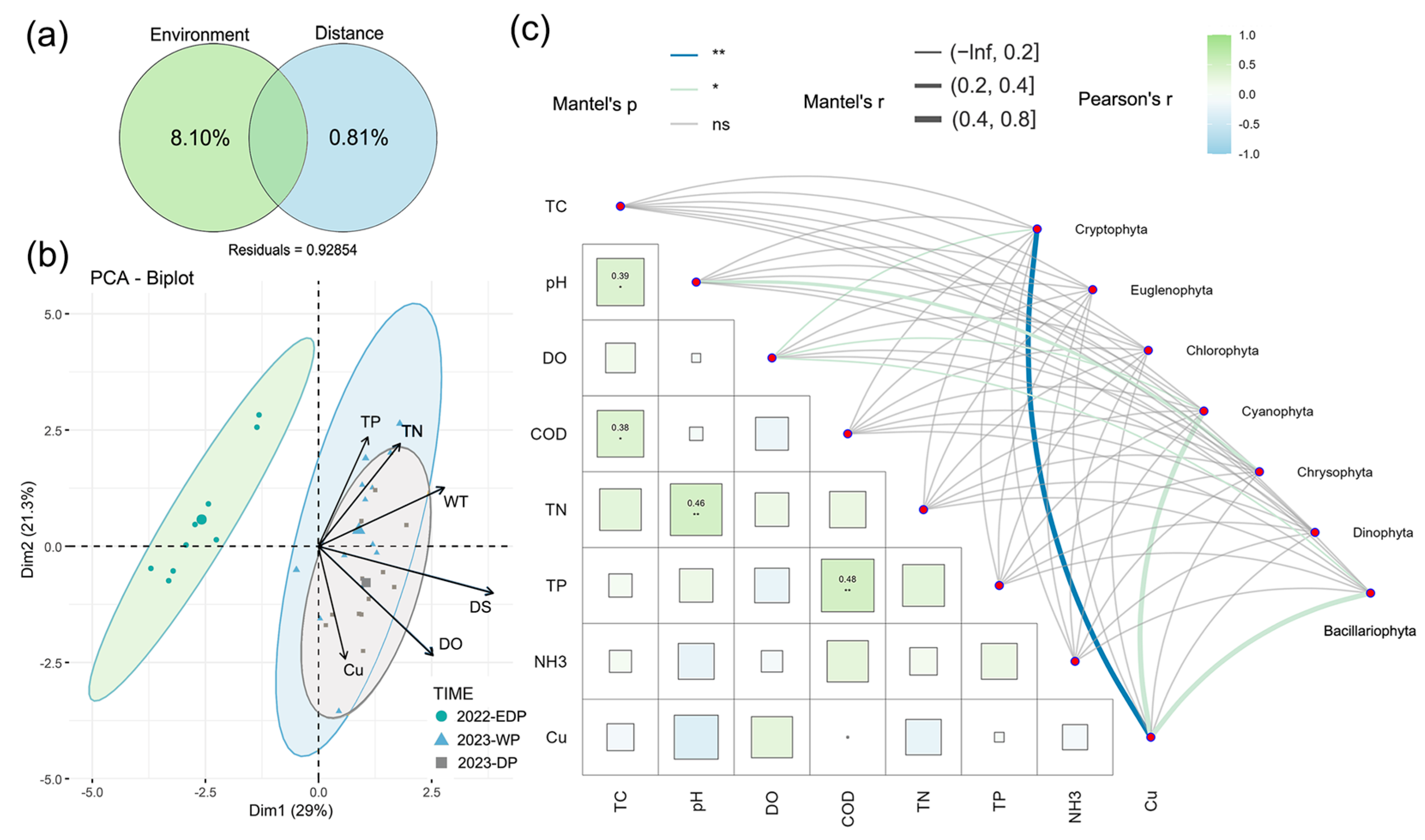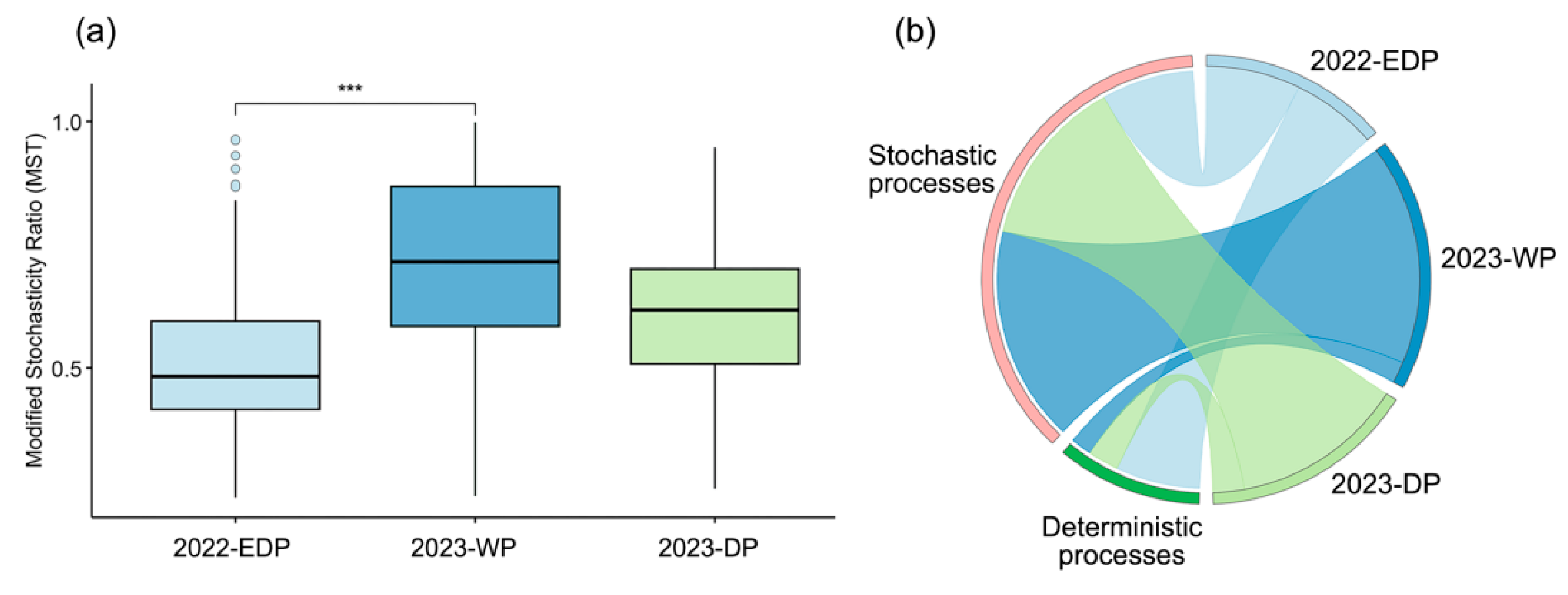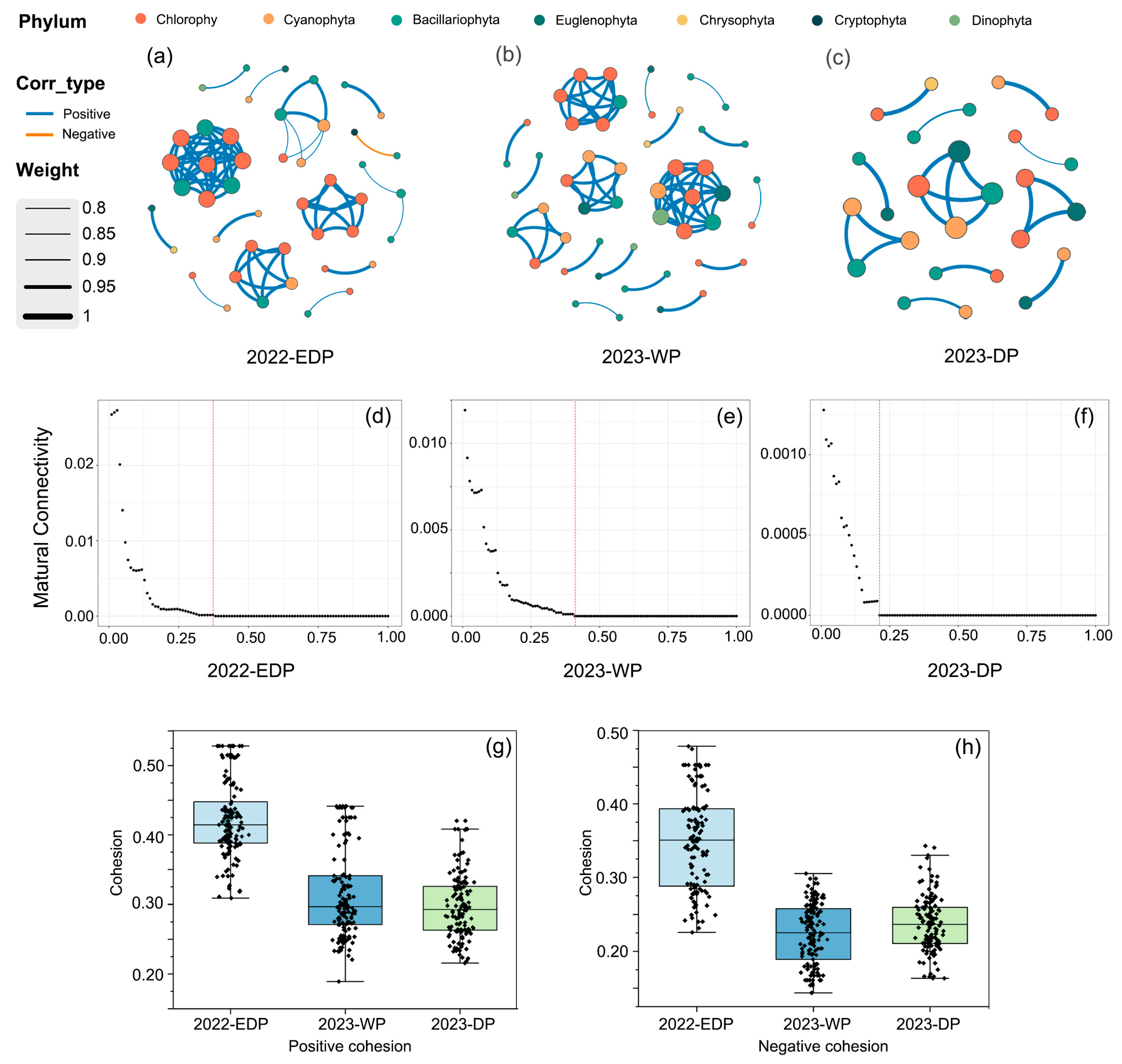How Does Extreme Drought Affect Phytoplankton Community Assembly in Aquatic Reserves? A Study from the Confluence of Poyang Lake and Yangtze River, China
Abstract
1. Introduction
2. Materials and Methods
2.1. The Study Area and Investigation Period
2.2. Aquatic Environmental Parameters
2.3. Sampling and Identification of Phytoplankton
2.4. Phytoplankton Functional Groups
2.5. Statistical Analysis
3. Results
3.1. Environmental Parameters
3.2. Phytoplankton Community Assemblage Structure
3.3. Dominant Phytoplankton Species
3.4. Phytoplankton Community Functional Groups
3.5. Relationships Between Environmental Factors and Phytoplankton Community
3.6. Community Assembly Mechanisms of Phytoplankton Communities
3.7. Co-Occurrence Network Stability and Complexity of Phytoplankton Communities
4. Discussion
4.1. Patterns of Phytoplankton Community Diversity Caused by Drought
4.2. Analysis of the Construction Mechanism and Driving Mechanism of Arid Phytoplankton Community
5. Conclusions
Author Contributions
Funding
Data Availability Statement
Acknowledgments
Conflicts of Interest
Appendix A
| Site | Water Body | Aquatic Reserves |
|---|---|---|
| 1 | Yangtze River Mainstem | Yangtze River Jiangxi Section Four Major Chinese Carps National Aquatic Germplasm Resources Conservation Zone Core Area |
| 2 | Yangtze River Mainstem | Yangtze River Jiangxi Section Four Major Chinese Carps National Aquatic Germplasm Resources Conservation Zone Experimental Area |
| 3 | Yangtze River Mainstem | Yangtze River Bajiang Section Leiocassis longirostris National Aquatic Germplasm Resources Conservation Zone Core Area |
| 4 | Yangtze River Mainstem | Yangtze River Bajiang Section Leiocassis longirostris National Aquatic Germplasm Resources Conservation Zone Experimental Area |
| 5 | Poyang Lake | Yangtze River Bajiang Section Leiocassis longirostris National Aquatic Germplasm Resources Conservation Zone |
| 6 | Poyang Lake | Poyang Lake Yangtze Neophocaena asiaeorientalis Provincial Nature Reserve |
| 7 | Boyang River | De’an County Boyang River Culter alburnus and Pelteobagrus fulvidraco National Aquatic Germplasm Resources Conservation Zone |
| 8 | Boyang River | De’an County Boyang River Culter alburnus and Pelteobagrus fulvidraco National Aquatic Germplasm Resources Conservation Zone |
| 9 | Xiu River Mainstem | Lower Xiuhe River Hyriopsis cumingii National Aquatic Germplasm Resources Conservation Zone |
| 10 | Xiu River Mainstem | Lushanxihi Lake Elopichthvs bambusa National Aquatic Germplasm Resources Conservation Zone |
| 11 | Xiu River Mainstem | Lushanxihi Lake Elopichthvs bambusa National Aquatic Germplasm Resources Conservation Zone |
| 12 | Xiu River Mainstem | Liuxi River Spinibarbus hollandi of Aquatic Germplasm Resources National Conservation Zone |
| Index | 22-EDP | 23-WP | 23-DP |
|---|---|---|---|
| WT/°C | 21.04 ± 0.93 | 23.26 ± 1.28 | 22.58 ± 1.5 |
| pH | 7.2 ± 0.37 | 7.29 ± 0.2 | 7.19 ± 0.14 |
| DO/(mg/L) | 7.38 ± 0.38 | 9.76 ± 1.57 | 9.93 ± 1.28 |
| CODMn/(mg/L) | 1.45 ± 0.42 | 2.06 ± 1.09 | 1.83 ± 0.75 |
| TN/(mg/L) | 1.2 ± 0.68 | 1.61 ± 0.33 | 1.31 ± 0.54 |
| TP/(mg/L) | 0.05 ± 0.03 | 0.06 ± 0.03 | 0.06 ± 0.05 |
| TN/TP | 33.65 ± 22.02 | 48.608 ± 47.008 | 45.994 ± 39.47 |
| NH3-N/(mg/L) | 0.002 ± 0.002 | 0.004 ± 0.004 | 0.003 ± 0.002 |
| Cu/(mg/L) | 0.002 ± 0.003 | 0.003 ± 0.003 | 0.004 ± 0.002 |
| Time Period | Sep 2022 | Oct 2022 | Nov 2022 | Dec 2022 | Jan 2023 | Feb 2023 | Mar 2023 | Apr 2023 | May 2023 | Jun 2023 | Jul 2023 | Aug 2023 | Sep 2023 | Oct 2023 | Nov 2023 | Dec 2023 |
|---|---|---|---|---|---|---|---|---|---|---|---|---|---|---|---|---|
| Precipitation (mm) | 85 | 60 | 45 | 30 | 50 | 75 | 120 | 150 | 200 | 280 | 250 | 180 | 90 | 70 | 40 | 35 |
References
- Ummenhofer, C.C.; Meehl, G.A. Extreme weather and climate events with ecological relevance: A review. Philos. Trans. R. Soc. B Biol. Sci. 2017, 372, 20160135. [Google Scholar] [CrossRef] [PubMed]
- Graham, D.J.; Bierkens, M.F.P.; Van Vliet, M.T.H. Impacts of droughts and heatwaves on river water quality worldwide. J. Hydrol. 2024, 629, 130590. [Google Scholar] [CrossRef]
- Zhang, P.; Zou, Y.; Tao, K.; Zhang, S.; Li, F.; Deng, Z.; Zeng, J.; Xie, Y.; Liu, X.; Li, F. Extreme drought alters waterfowl distribution patterns and spatial niches in floodplain wetlands. Glob. Ecol. Conserv. 2024, 51, e02901. [Google Scholar] [CrossRef]
- Qiu, J.; Shen, Z.; Xie, H. Drought impacts on hydrology and water quality under climate change. Sci. Total Environ. 2023, 858, 159854. [Google Scholar] [CrossRef]
- Xu, H.; Paerl, H.W.; Qin, B.; Zhu, G.; Gaoa, G. Nitrogen and phosphorus inputs control phytoplankton growth in eutrophic Lake Taihu, China. Limnol. Oceanogr. 2010, 55, 420–432. [Google Scholar] [CrossRef]
- Bao, Q.; He, H.; Tang, H.; Tang, X.; Li, X.; Ding, Y.; Zhao, M. Spatial and temporal characteristics of phytoplankton community structure and their environmental driving factors in Lake Lugu. J. Lakes Sci. 2025, 1–18. [Google Scholar]
- Yang, J.R.; Lv, H.; Isabwe, A.; Liu, L.; Yu, X.; Chen, H.; Yang, J. Disturbance-induced phytoplankton regime shifts and recovery of cyanobacteria dominance in two subtropical reservoirs. Water Res. 2017, 120, 52–63. [Google Scholar] [CrossRef]
- Xu, Z.; Cheung, S.; Endo, H.; Xia, X.; Wu, W.; Chen, B.; Ho, N.H.E.; Suzuki, K.; Li, M.; Liu, H. Disentangling the Ecological Processes Shaping the Latitudinal Pattern of Phytoplankton Communities in the Pacific Ocean. mSystems 2022, 7, e0120321. [Google Scholar] [CrossRef] [PubMed]
- Liu, H.; Cheng, W.; Xiong, P.; Li, H.; Liu, Z.; Ai, J.; Yuan, D.; Wan, F.; Wan, Y.; Zou, H.; et al. Temporal variation of plankton and zoobenthos communities in a freshwater reservoir: Structure feature, construction mechanism, associated symbiosis and environmental response. Ecol. Indic. 2023, 154, 110774. [Google Scholar] [CrossRef]
- Chao, X.; Yang, S.X.; Liu, H.Q.; Yan, B.J.; Wei, P.P.; Wu, X.J.; Ba, S. Mechanism and driving factors of phytoplankton community construction in the lower reaches of Yarlung Zangbo River. J. Lakes Sci. 2025, 37, 215–229. [Google Scholar]
- Li, X.; Chen, K.; Wang, C.; Zhuo, T.; Li, H.; Wu, Y.; Lei, X.; Li, M.; Chen, B.; Chai, B. Deciphering environmental factors influencing phytoplankton community structure in a polluted urban river. J. Environ. Sci. 2025, 148, 375–386. [Google Scholar] [CrossRef] [PubMed]
- Jiang, Y.; Wang, Y.; Huang, Z.; Zheng, B.; Wen, Y.; Liu, G. Investigation of phytoplankton community structure and formation mechanism: A case study of Lake Longhu in Jinjiang. Front. Microbiol. 2023, 14, 1267299. [Google Scholar] [CrossRef] [PubMed]
- Xiao, W.; Laws, E.A.; Xie, Y.; Wang, L.; Liu, X.; Chen, J.; Chen, B.; Huang, B. Responses of marine phytoplankton communities to environmental changes: New insights from a niche classification scheme. Water Res. 2019, 166, 115070. [Google Scholar] [CrossRef] [PubMed]
- Wu, T.; Gao, R.; Tang, X.; Chu, Z.; Ye, B.; Yuan, Z. Light limitation during a compound drought and heat event inhibited algal blooms in a nutrient-rich shallow lake. Harmful Algae 2025, 142, 102796. [Google Scholar] [CrossRef]
- Yu, Q.; Xu, C.; Wu, H.; Ke, Y.; Zuo, X.; Luo, W.; Ren, H.; Gu, Q.; Wang, H.; Ma, W.; et al. Contrasting drought sensitivity of Eurasian and North American grasslands. Nature 2025, 639, 114–118. [Google Scholar] [CrossRef]
- Yang, H.L.; Shen, L.; He, Y.F.; Tian, H.W.; Gao, L.; Wu, J.M.; Mei, Z.G.; Wei, N.; Wang, L.; Zhu, T.B.; et al. Survey of Yangtze River Aquatic Resources and Environmental Background (2017–2021). Acta Hydrobiol. Sin. 2023, 47, 3–30. [Google Scholar]
- Wang, C.; Wang, X.; Xu, Y.J.; Lv, Q.; Ji, X.; Jia, S.; Liu, Z.; Mao, B. Nitrogen and phosphorus evolution process and driving mechanisms of three major freshwater lakes with different river-lake connectivity (DRLC) in the lower reaches of the Yangtze river, the largest river in Asia. J. Clean. Prod. 2025, 486, 144471. [Google Scholar] [CrossRef]
- Qian, K.; Liu, X.; Chen, Y. Effects of water level fluctuation on phytoplankton succession in Poyang Lake, China—A five year study. Ecohydrol. Hydrobiol. 2016, 16, 175–184. [Google Scholar] [CrossRef]
- Liu, J.; Zou, H.; Deng, F.; Liu, Y.; Li, W.; Xu, J.; Liu, S.; Wu, Q.; Zhang, X.; Weng, F.; et al. Phytoplankton functional groups in Poyang Lake: Succession and driving factors. J. Oceanol. Limnol. 2024, 42, 1764–1776. [Google Scholar] [CrossRef]
- Zhang, Z.S.; Huang, X.F. Research Methods of Freshwater Plankton; Science Press: Beijing, China, 1991. [Google Scholar]
- Editorial Board of “Monitoring and Analysis Methods of Water and Wastewater”; Ministry of Environmental Protection of the People’s Republic of China (Eds.) Monitoring and Analysis Methods of Water and Wastewater, 4th ed.; China Environmental Science Press: Beijing, China, 2002. [Google Scholar]
- Li, G.J.; Feng, J.P.; Ye, J.S. Alteration of water quality and succession characteristic of phytoplankton community in Nansha harbor area. Ecol. Sci. 2021, 40, 164–171. [Google Scholar]
- Zhao, W. Aquatic Biology; China Agriculture Press: Beijing, China, 2005. [Google Scholar]
- Wang, Q.X. Atlas of Algae in Shanghai Jiuduansha Wetland Nature Reserve and Its Adjacent Waters; Science Press: Beijing, China, 2008. [Google Scholar]
- Hu, H.J.; Wei, Y.X. The Freshwater Algae of China Systematics, Taxonomy and Ecology; Sciences Press: Beijing, China, 2006. [Google Scholar]
- Reynolds, C.S.; Huszar, V.; Kruk, C.; Naselli-Flores, L.; Melo, S. Towards a functional classification of the freshwater phytoplankton. J. Plankton Res. 2002, 24, 417–428. [Google Scholar] [CrossRef]
- Sun, X.; Wang, W. The impact of environmental parameters on phytoplankton functional groups in northeastern China. Ecol. Eng. 2021, 164, 106209. [Google Scholar] [CrossRef]
- Kozak, A.; Budzyńska, A.; Dondajewska-Pielka, R. Functional Groups of Phytoplankton and Their Relationship with Environmental Factors in the Restored Uzarzewskie Lake. Water 2020, 12, 313. [Google Scholar] [CrossRef]
- Padisak, J.; Crossetti, L.O.; Naselli-Flores, L. Use and misuse in the application of the phytoplankton functional classification: A critical review with updates. Hydrobiologia 2009, 621, 1–19. [Google Scholar] [CrossRef]
- Qian, Q.; Liu, B.; Chen, Y. Long term dynamics of phytoplankton functional groups in Lake Poyang during 2009-2016. J. Lakes Sci. 2019, 31, 1035–1044. [Google Scholar]
- Yang, L.; Zhang, W.; Shang, G.-X.; Zhang, J.-Y.; Wang, L.-Q.; Wei, H. Succession Characteristics of Phytoplankton Functional Groups and Their Relationships with Environmental Factors in Dianshan Lake, Shanghai. Environ. Sci. 2018, 39, 3158–3167. [Google Scholar]
- Mcnaughton, S.J. Relationships among Functional Properties of Californian Grassland. Nature 1967, 216, 168–169. [Google Scholar] [CrossRef]
- Dixon, P. VEGAN, A Package of R Functions for Community Ecology. J. Veg. Sci. 2003, 14, 927–930. [Google Scholar] [CrossRef]
- Ning, D.; Deng, Y.; Tiedje, J.M.; Zhou, J. A general framework for quantitatively assessing ecological stochasticity. Proc. Natl. Acad. Sci. USA 2019, 116, 16892–16898. [Google Scholar] [CrossRef]
- Li, P.; Li, W.; Dumbrell, A.J.; Liu, M.; Li, G.; Wu, M.; Jiang, C.; Li, Z. Spatial Variation in Soil Fungal Communities across Paddy Fields in Subtropical China. mSystems 2020, 5, e00704-19. [Google Scholar] [CrossRef]
- Herren, C.M.; McMahon, K.D. Cohesion: A method for quantifying the connectivity of microbial communities. ISME J. 2017, 11, 2426–2438. [Google Scholar] [CrossRef] [PubMed]
- Yuan, M.M.; Guo, X.; Wu, L.; Zhang, Y.A.; Xiao, N.; Ning, D.; Shi, Z.; Zhou, X.; Wu, L.; Yang, Y.; et al. Climate warming enhances microbial network complexity and stability. Nat. Clim. Change 2021, 11, 343–348. [Google Scholar] [CrossRef]
- Wang, J.; Liu, Q.; Zhao, X.; Borthwick, A.G.L.; Liu, Y.; Chen, Q.; Ni, J. Molecular biogeography of planktonic and benthic diatoms in the Yangtze River. Microbiome 2019, 7, 153. [Google Scholar] [CrossRef] [PubMed]
- Liu, Q.; Wang, T.; Xu, X.; Ni, J. Spatiotemporal Distribution and Its Influence Factors of Diatoms in the Middle and Lower Reaches of Hanjiang River. Acta Sci. Nat. Univ. Pekin. 2018, 54, 848–856. [Google Scholar]
- Gelis, M.N.; Sathicq, M.B.; del Puerto, J.P.; Pazos, R.S.; Tarda, A.S.; Gómez, N. Impact of extreme drought on diatom traits and species composition in temperate lowland streams. Hydrobiologia 2025, 852, 629–644. [Google Scholar] [CrossRef]
- Padisák, J.; Naselli-Flores, L. Phytoplankton in extreme environments: Importance and consequences of habitat permanency. Hydrobiologia 2021, 848, 157–176. [Google Scholar] [CrossRef]
- Simeunović, J.; Bešlin, K.; Svirčev, Z.; Kovač, D.; Babić, O. Impact of nitrogen and drought on phycobiliprotein content in terrestrial cyanobacterial strains. J. Appl. Phycol. 2013, 25, 597–607. [Google Scholar] [CrossRef]
- Rühland, K.M.; Paterson, A.M.; Smol, J.P. Lake diatom responses to warming: Reviewing the evidence. J. Paleolimnol. 2015, 54, 1–35. [Google Scholar] [CrossRef]
- Jing, D.Q.; Chai, Y.H.; Ju, Y.F.; Chai, Q.Y.; Yu, H.X.; Chai, F.Y.; Sun, X. Study on Phytoplankton Functional Groups and Nutrient Levels in Tuanjie Reservoir. Open J. Nat. Sci. 2021, 9, 672. [Google Scholar] [CrossRef]
- Yan, G.; Yin, X.; Wang, X.; Zhang, Y.; Wang, E.; Yu, Z.; Ma, X.; Huang, M. Effects of Summer and Autumn Drought on Eutrophication and the Phytoplankton Community in Dongting Lake in 2022. Toxics 2023, 11, 822. [Google Scholar] [CrossRef]
- Knapp, A.S.; Milewski, A.M. Spatiotemporal Relationships of Phytoplankton Blooms, Drought, and Rainstorms in Freshwater Reservoirs. Water 2020, 12, 404. [Google Scholar] [CrossRef]
- Liu, Y.J.; Liu, X.; Mu, X.Z.; Wu, L. Research status of microorganisms in a large, shallow lake Poyang Lake wetland. Microbiol. China 2019, 46, 3453–3460. [Google Scholar]
- Luo, J.H.; Yan, Y.; Xiao, F.; Cao, S.H.; Chen, M.M.; Du, Y. Monitoring and analysis of the Lake Poyang wetland drought process in 2022 based on spatiotemporal information fusion model. J. Lakes Sci. 2024, 36, 1525–1536. [Google Scholar]
- Li, W.X.; Jiang, M.L.; Xu, L.G.; Hu, S.P.; You, H.L.; Zhou, Q.P.; Chen, Z.; Zhang, L. Spatial and temporal characteristics of phytoplankton in Lake Poyang and its response to extreme flood and drying events. J. Lakes Sci. 2024, 36, 1001–1013. [Google Scholar]
- Deng, W.W.; Wang, R.; Liu, Z.W.; Zhen, W.X.; Zhang, C.X. The influencing factors of critical transition in shallow lakes revealed by model. Adv. Earth Sci. 2021, 36, 83–94. [Google Scholar]
- Lopez, J.S.; Lee, L.; Mackey, K.R.M. The Toxicity of Copper to Crocosphaera watsonii and Other Marine Phytoplankton: A Systematic Review. Front. Mar. Sci. 2019, 5, 511. [Google Scholar] [CrossRef]
- Li, J.H.; Zeng, Z.Q. Effects of Co, Ni, Cu, Zn ions on spectra of phycobiliprotein vesicle. J. Nanjing Univ. 1997, 33, 639–643. [Google Scholar]
- Wang, L.; Wei, W.; Zhou, P.; Li, Y.; Sun, Q.-Y. Phytoplankton’s community structure and its relationships with environmental factors in the rivers of Tongling City, Anhui Province of East China in winter. Chin. J. Appl. Ecol. 2013, 24, 243–250. [Google Scholar]
- Wang, L.P.; Zheng, B.H. Eutrophication development and its key affected factors in the Yanghe Reservoir. Acta Ecol. Sin. 2013, 33, 1011–1017. [Google Scholar] [CrossRef][Green Version]
- Vignardi, C.P.; Adeleye, A.S.; Kayal, M.; Oranu, E.; Miller, R.J.; Keller, A.A.; Holden, P.A.; Lenihan, H.S. Aging of Copper Nanoparticles in the Marine Environment Regulates Toxicity for a Coastal Phytoplankton Species. Environ. Sci. Technol. 2023, 57, 6989–6998. [Google Scholar] [CrossRef]
- Berry, D.; Widder, S. Deciphering microbial interactions and detecting keystone species with co-occurrence networks. Front. Microbiol. 2014, 5, 219. [Google Scholar] [CrossRef] [PubMed]
- Fu, H.; Cai, G.; Özkan, K.; Johansson, L.S.; Søndergaard, M.; Lauridsen, T.L.; Yuan, G.; Jeppesen, E. Re-oligotrophication and warming stabilize phytoplankton networks. Water Res. 2024, 253, 121325. [Google Scholar] [CrossRef] [PubMed]
- Fuhrman, J.A. Microbial community structure and its functional implications. Nature 2009, 459, 193–199. [Google Scholar] [CrossRef] [PubMed]
- Gomez-Casati, D.F.; Pernice, M.; Tonon, T. Algae. Sci. Rep. 2025, 15, 2034. [Google Scholar] [CrossRef]
- Toruan, R.L.; Dina, R.; Coggins, L.X.; Ghadouani, A. Hydrological Regime and Fish Predation Regulate the Zooplankton Community Size Structure in a Tropical Floodplain Lake. Water 2022, 14, 2518. [Google Scholar] [CrossRef]
- Jeppesen, E.; Meerhoff, M.; Davidson, T.A.; Trolle, D.; Søndergaard, M.; Lauridsen, T.L.; Beklioglu, M.; Brucet, S.; Volta, P.; González-Bergonzoni, I.; et al. Climate change impacts on lakes: An integrated ecological perspective based on a multi-faceted approach, with special focus on shallow lakes. J. Limnol. 2014, 73, 88–111. [Google Scholar] [CrossRef]
- Rusanov, A.G.; Bíró, T.; Kiss, K.T.; Buczkó, K.; Grigorszky, I.; Hidas, A.; Duleba, M.; Trábert, Z.; Földi, A.; Ács, É. Relative importance of climate and spatial processes in shaping species composition, functional structure and beta diversity of phytoplankton in a large river. Sci. Total Environ. 2022, 807, 150891. [Google Scholar] [CrossRef]
- Nõges, P.; Argillier, C.; Borja, Á.; Garmendia, J.M.; Hanganu, J.; Kodeš, V.; Pletterbauer, F.; Sagouis, A.; Birk, S. Quantified biotic and abiotic responses to multiple stress in freshwater, marine and ground waters. Sci. Total Environ. 2016, 540, 43–52. [Google Scholar] [CrossRef]






| Phylum | Dominant Species | Dominance (Y) | ||
|---|---|---|---|---|
| 2022-EDP | 2023-WP | 2023-DP | ||
| Cyanophyta | Dolichospermum sp. | 0.03 | 0.08 | — |
| Microcystis aeruginosa | 0.02 | — | — | |
| Planktothrix agardhii | 0.04 | — | — | |
| Raphidiopsis sp. | — | — | 0.02 | |
| Chlorophyta | Actinastrum sp. | — | — | 0.02 |
| Pediastrum duplex var. gracillimum | — | 0.02 | — | |
| Pediastrum simplex var. duodenarium | 0.03 | 0.02 | 0.02 | |
| Scenedesmus quadricauda | — | — | 0.03 | |
| Bacillariophyta | Aulacoseira granulata | 0.08 | 0.11 | 0.13 |
| Aulacoseira granulata var. angustissima | 0.02 | 0.03 | 0.03 | |
| Gyrosigma sp. | — | — | 0.02 | |
| Navicula sp. | 0.05 | — | — | |
| Ulnaria acus | 0.10 | 0.13 | 0.10 | |
| Ulnaria ulna | 0.04 | — | — | |
| FGs | Representative Algal Genus (Species) | Dominance | FGs | Representative Algal Genus (Species) | Dominance | ||||
|---|---|---|---|---|---|---|---|---|---|
| 2022-EDP | 2023-WP | 2023-DP | 2022-EDP | 2023-WP | 2023-DP | ||||
| A | Attheya zachariasi | — | — | — | P | Closterium sp. Aulacoseira granulata Aulacoseira granulata var. angustissima | 14.17% | 10.37% | — |
| B | Aulacoseira granulata | — | — | — | S1 | Phormidium sp. Planktothrix spp. | 7.96% | — | — |
| C | Asterionella Formosa Cyclotella meneghiniana | — | — | — | S2 | Spirulina spp. | — | — | — |
| D | Nitzschia spp. Ulnaria acus Ulnaria ulna | 10.47% | 7.72% | 5.68% | SN | Raphidiopsis spp. | — | — | — |
| E | Dinobryon sp. Mallomonas candata | — | — | — | TB | Melosira varians | — | — | — |
| F | Pectodictyon sp. Dictyosphaerium sp. Kirchneriella lunaris Micractinium pusillum Sphaerocystis schroeteri Treubaria triappendiculata | — | — | 7.96% | TC | Gloeocapsa punctata Planktolyngbya limnetica Lyngbya martensiana | — | — | — |
| G | Actinastrum hantzschii Eudorina elegans | — | — | — | TD | Spirogyra sp. | — | — | — |
| H1 | Anabaena spp. | — | — | — | W0 | Chlorella sp. | — | — | — |
| J | Coelastrum sp. Crucigenia tetrapedia Pediastrum spp. Scenedesmus spp. Tetraedron spp. | 8.54% | 13.0% | 17.4% | W1 | Phacus spp. Euglena spp. | 8.50% | 20.62% | 26.42% |
| K | Aphanothece sp. Aphanocapsa sp. | — | — | — | W2 | Trachelomonas spp. Strombomonas fluviatilis | — | 5.47% | — |
| Lm | Ceratium hirundinella | — | — | — | X1 | Ankistrodesmus spp. | — | — | — |
| Lo | Chroococcus minutus Merismopedia punctata | — | — | — | X3 | Schroederia spp. | — | — | — |
| M | Microcystis aeruginosa | — | — | — | Y | Cryptomonas erosa | — | — | — |
| MP | Cymbella spp. Gomphonema spp. Surirella spp. | 25.28% | 9.90% | 14.53% | Z | Synechococcus aeruginosus | — | — | — |
| N | Cosmarium sp. Staurastrum sp. | — | — | — | |||||
| Index | 22-EDP | 23-WP | 23-DP |
|---|---|---|---|
| Nodes | 45.00 | 49.00 | 26.00 |
| Edges | 74.00 | 72.00 | 20.00 |
| Positive associations | 0.99 | 1.00 | 1.00 |
| Negative associations | 0.01 | 0.00 | 0.00 |
| Average degree | 3.29 | 2.94 | 1.54 |
| Average shortest path length | 1.02 | 0.99 | 0.99 |
| Network diameter | 1.84 | 1.00 | 1.00 |
| Network density | 0.07 | 0.06 | 0.06 |
| Clustering coefficient | 0.98 | 1.00 | 1.00 |
| Modularity | 0.72 | 0.78 | 0.85 |
Disclaimer/Publisher’s Note: The statements, opinions and data contained in all publications are solely those of the individual author(s) and contributor(s) and not of MDPI and/or the editor(s). MDPI and/or the editor(s) disclaim responsibility for any injury to people or property resulting from any ideas, methods, instructions or products referred to in the content. |
© 2025 by the authors. Licensee MDPI, Basel, Switzerland. This article is an open access article distributed under the terms and conditions of the Creative Commons Attribution (CC BY) license (https://creativecommons.org/licenses/by/4.0/).
Share and Cite
Jiang, Y.; Shen, W.; Fang, L.; Zhang, B.; Kong, C.; Zhang, W.; Xu, Q. How Does Extreme Drought Affect Phytoplankton Community Assembly in Aquatic Reserves? A Study from the Confluence of Poyang Lake and Yangtze River, China. Diversity 2025, 17, 301. https://doi.org/10.3390/d17040301
Jiang Y, Shen W, Fang L, Zhang B, Kong C, Zhang W, Xu Q. How Does Extreme Drought Affect Phytoplankton Community Assembly in Aquatic Reserves? A Study from the Confluence of Poyang Lake and Yangtze River, China. Diversity. 2025; 17(4):301. https://doi.org/10.3390/d17040301
Chicago/Turabian StyleJiang, Yufei, Wenting Shen, Lei Fang, Bao Zhang, Chiping Kong, Wei Zhang, and Qun Xu. 2025. "How Does Extreme Drought Affect Phytoplankton Community Assembly in Aquatic Reserves? A Study from the Confluence of Poyang Lake and Yangtze River, China" Diversity 17, no. 4: 301. https://doi.org/10.3390/d17040301
APA StyleJiang, Y., Shen, W., Fang, L., Zhang, B., Kong, C., Zhang, W., & Xu, Q. (2025). How Does Extreme Drought Affect Phytoplankton Community Assembly in Aquatic Reserves? A Study from the Confluence of Poyang Lake and Yangtze River, China. Diversity, 17(4), 301. https://doi.org/10.3390/d17040301







